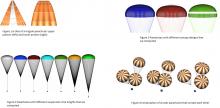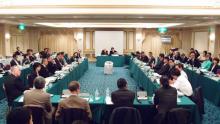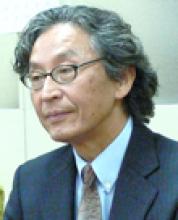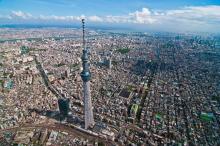Japan
News

03 May 2012
The Japanese government announced that it will award the Medal of Honor with Purple Ribbon to Dr. Tetsuya Ishikawa, RIKEN Harima Institute director, for his considerable contribution to the development of science and technology.
01 May 2012
OPINION - To me, space meant NASA and the space shuttle. But last year, finally, the space shuttle was retired. Therefore, the only way to return from space now is by using parachutes.

27 Apr 2012
We are pleased to announce that on 12th of April, 2012, Toyohashi Tech had made an exchange agreement between School of Innovation Science, Eindhoven University of Technology (TU/e).

24 Apr 2012
Team hopes findings will bolster practice’s reputation as a nonpharmacolgical treatment
19 Apr 2012
The High Energy Accelerator Research Organization (KEK), recently joined to TIA-nano as a new core institute, in addition to the existing core institutes, the National Institute of Advanced Industrial Science and Technology (AIST), the National Institute for Materials Science (NIMS), and the University of Tsukuba.
19 Apr 2012
On Monday, April 9, 2012, the US-Japan Higher Education Panel was held at the Rihga Royal Hotel Tokyo under Waseda University’s auspices.

12 Apr 2012
The 2nd Conference of University Presidents in Japan and Vietnam was held at the University of Kyoto on March 12 and 13, and in which Toyohashi Tech President Sakaki and Vice President Tsunoda participated.
10 Apr 2012
OPINION - The big issue currently faced by contemporary society is how it can redevelop a modern “principle of freedom” in a more real way.
10 Apr 2012
OPINION - Politics used to be a risky business, but politicians these days seem to regard politics as an arena that is tranquil and uneventful, where they can make a fortune if they declare that their efforts are for the sake of the nation and the people or that they think from the standpoint of the people.
04 Apr 2012
Nishioka and Ichikawa, researchers from Japan’s largest steel production company, describe recent developments in TMCP Technology in the latest issue of Science and Technology of Advanced Materials Vol. 13 (2012).
03 Apr 2012
On April 1, 2012, MANA enters its second term. This is an accomplishment in which all of us at MANA take great pride, and one that would not be possible without your support over the last four and a half years.
02 Apr 2012
The University of Tokyo (Tokyo, Japan) and the Japan Science and Technology Agency (JST) announced on 6th March 2012 that an international research team led by Professor Takao Someya has succeeded in manufacturing the world’s first flexible organic transistor on a polymeric film.
02 Apr 2012
Nippon Telegraph and Telephone Corporation (NTT) announced that they have developed a current-injection photonic-crystal laser with ultralow power consumption, which can be applicable to both off-chip and on-chip optical data transmission for microprocessors.

30 Mar 2012
In the Osaka mayoral election held on November 27 last year, the former Governor of Osaka Toru Hashimoto won an overwhelming victory over incumbent Kunio Hiramatsu.

30 Mar 2012
A voice is directed at those nearby and reaches them. That is probably what poems were in the first place. Or else words written on paper. And to reach people, they had to be transcribed again and again. And so printing machines came into being to replace the human hand. And so more time became necessary to get the words to the people.

30 Mar 2012
Japan was stricken by a triple crisis of mega earthquakes, monster tsunami, and nuclear meltdown at Fukushima.

30 Mar 2012
The Great East Japan Earthquake has dramatically altered the way the Japanese economy is seen. For example, the way that housing and real estate values are seen in Japan has changed since 3.11. Location value is what determines the values of homes and real estate.

30 Mar 2012
Conserving electricity is an absolute necessity due to the power shortage associated with the Great East Japan Earthquake Disaster.

30 Mar 2012
This earthquake and the tsunami claimed the lives of a large number of persons with disabilities.

30 Mar 2012
About 30 years ago, I drove northward from Sotobo in Chiba along the coastline in Fukushima and Miyagi as far as accessible by road, passing through inland areas in Iwate to Miyako again, and went up north to the Shimokita Peninsula.

30 Mar 2012
The accident at Fukushima Daiichi Nuclear Power Plant caused by the East Japan Great Earthquake Disaster has made it necessary to fundamentally revise the existing nuclear-centric energy policy.

30 Mar 2012
It will be hot this summer. This is not a prediction that this summer will be as hot as last summer, but it does mean that the temperature will be higher in offices and homes to conserve energy.

30 Mar 2012
Buildings have service lives. This seems obvious to Japanese, but might be seen as strange by Westerners.

30 Mar 2012
Every stricken area I saw from the air on March 19 was covered with mud and had turned grey.

30 Mar 2012
Although the people in the coastal areas there had the highest awareness of tsunamis in the nation, many of them could not run in time from the tsunami that far exceeded their expectations, reaching more than ten meters in height, claiming the lives of many victims, and leaving nothing but piles of rubble.

30 Mar 2012
On May 1st—some 50 days after the Eastern Japan Great Earthquake Disaster—we visited Kesennuma City in Miyagi Prefecture, which was severely affected by tsunamis, to conduct surveys and collect information on the earthquake disaster and the media.

30 Mar 2012
A vast expanse of land has been reclaimed along the coastal areas in Japan’s large urban areas, Tokyo Bay, Ise Bay, and Osaka Bay.

30 Mar 2012
The TEPCO Fukushima accident caused severe trouble for the public, beginning with the citizens of Fukushima prefecture, and we must ensure that an accident such as this never occurs again.

30 Mar 2012
For a century, Japanese electric power utilities (electric power companies) have been striving to build electric power systems that can stably supply consumers with high-quality electric power at low rates, which is a very difficult task.
Researchers
Sorry, no researchers coming up for this topic.
Giants in history
Ruby Sakae Hirose (1904 – 1960) was a Japanese-American scientist whose research contributed significantly to our understanding of blood clotting, allergies and cancer.
Haisako Koyama (1916 – 1997) was a Japanese solar observer whose dedication to recording sunspots – cooler parts of the sun’s surface that appear dark – produced a sunspot record of historic importance.
Michiaki Takahashi (17 February 1928 – 16 December 2013) was a Japanese virologist who developed the first chickenpox vaccine.
Toshiko Yuasa (11 December 1909 – 1 February 1980) was the first Japanese female physicist whose research on radioactivity shed light on beta decay – the process in which an atom emits a beta particle (electron) and turns into a different element.
Baron Kitasato Shibasaburo (29 January 1856 – 13 June 1931) was a Japanese physician and bacteriologist whose work led to a new understanding of preventing and treating tetanus, diphtheria and anthrax.
By isolating soil microorganisms and studying the compounds they produce, Satoshi Omura (born 1935) discovered almost 500 organic compounds with unique properties that were produced by these microorganisms, including many new antibiotics.
In 1915, pathologist Katsusaburo Yamagiwa and his research assistant Koichi Ichikawa became the first to prove that chronic exposure to chemicals can cause cancer.
In 1915, Koichi Ichikawa along with pathologist Katsusaburo Yamagiwa became the first to prove that chronic exposure to chemicals can cause cancer.
Reiji Okazaki (8 October 1930 – 1 August 1975) and Tsuneko (7 June 1933) were a Japanese couple who discovered Okazaki fragments – short sequences of DNA that are synthesized during DNA replication and linked together to form a continuous strand.
Tsuneko (7 June 1933) and Reiji Okazaki (8 October 1930 – 1 August 1975) were a Japanese couple who discovered Okazaki fragments – short sequences of DNA that are synthesized during DNA replication and linked together to form a continuous strand.
Husband and wife team, Kimishige (3 December 1925 – 6 July 2018) and Teruko Ishizaka (28 September 1926 – 4 June 2019) discovered the antibody class Immunoglobulin E (IgE) that triggers allergic reactions. They also discovered that IgE antibodies attach to white blood cells, known as mast cells, releasing histamine, which causes allergic reactions.
Husband and wife team, Kimishige (3 December 1925 – 6 July 2018) and Teruko Ishizaka (28 September 1926 – 4 June 2019) discovered the antibody class Immunoglobulin E (IgE) that triggers allergic reactions. They also discovered that IgE antibodies attach to white blood cells, known as mast cells, releasing histamine, which causes allergic reactions.
Japanese chemist Takamine Jokichi (3 November 1854 – 22 July 1922) founded the Tokyo Artificial Fertilizer Company, where he isolated a starch-digesting enzyme (named takadiastase) from the fungus Aspergillus oryzae.
Hideki Yukawa (23 January 1907 – 8 September 1981) was awarded the Nobel Prize in Physics in 1949 for predicting the existence of the pi meson subatomic particle. Japan’s first Nobel laureate, Yakawa also expressed his support for nuclear disarmament by signing the Russell–Einstein Manifesto in 1955.
Shinichiro Tomonaga (31 March 1906 – 8 July 1979), together with Richard Feynman and Julian Schwinger, was awarded the Nobel Prize in Physics in 1965, for their contributions to advance the field of quantum electrodynamics. Tomonaga was also a strong proponent of peace, who actively campaigned against the proliferation of nuclear weapons and promoted the peaceful use of nuclear energy.
Japanese chemist Kenichi Fukui (4 October 1918 – 9 January 1998) was the first Asian scientist to be awarded the Nobel Prize in Chemistry. Together with Roald Hoffman, he received this honour in 1981 for his independent research into the mechanisms of chemical reactions.
Minoru Shirota (April 23, 1899 – March 10, 1982) was a Japanese microbiologist who invented the popular fermented drink Yakult.
Japanese physicist Ukichiro Nakaya (1900-1962) made the world’s first artificial snowflakes. He started his research on snow crystals in the early 1930s at Hokkaido University, where there is an unlimited supply of natural snow in winter. By taking over 3,000 photographs, he established a classification of natural snow crystals and described their relationship with weather conditions.
The techniques that make industrial pearl culturing possible were developed over a century ago at the Misaki Marine Biological Station in Japan. The station’s first director, Professor Kakichi Mitsukuri, emphasized to Kokichi Mikimoto in 1890 that stimulating pearl sac formation was important for pearl growth, and they went on to successfully develop methods for culturing pearls.
The field of solid-state ionics originated in Europe, but Takehiko Takahashi of Nagoya University in Japan was the first to coin the term ‘solid ionics’ in 1967. ‘Solid-state ionics’ first appeared in 1971 in another of his papers, and was likely a play on ‘solid-state electronics’, another rapidly growing field at the time.
Chika Kuroda (24 March 1884 – 8 November 1968) was a Japanese chemist whose research focussed on the structures of natural pigments.
Motoo Kimura (13 November 1924 – 13 November 1994) was a Japanese theoretical population geneticist who is best remembered for developing the neutral theory of molecular evolution.
Osamu Shimomura (27 August 1928 – 19 October 2018) was a Japanese organic chemist and marine biologist who dedicated his career to understanding how organisms emitted light.
Kikunae Ikeda (8 October 1864 – 3 May 1936) was a Japanese chemist who discovered the fifth basic taste, umami.
Umetaro Suzuki (7 April 1874 – 20 September 1943) was a Japanese scientist best remembered for his research on beriberi, a disease caused by vitamin B1 deficiency, characterized by limb stiffness, paralysis and pain.
Kono Yasui (16 February 1880 – 24 March 1971) was a Japanese botanist who researched the genetics of poppies, corn and spiderworts and surveyed the plants that had been affected by the nuclear fallout after the atomic bombings of Hiroshima and Nagasaki.
Hitoshi Kihara (1893 – 1986) was one of the most famous Japanese geneticists of the 20th century. One of his most significant contributions was identifying sex chromosomes (X and Y) in flowering plants.
Michiyo Tsujimura (17 September 1888 – 1 June 1969) was a Japanese agricultural scientist and biochemist recognized for her research of green tea components.
A Japanese surgeon, Tetsuzo Akutsu (20 August 1922 – 9 August 2007) built the first artificial heart capable of keeping an animal alive.
Ogino Ginko (3 March 1851 – 23 June 1913) was the first registered female doctor to practise modern medicine in Japan.
Japanese geochemist Katsuko Saruhashi developed the first method and tools for measuring carbon dioxide in seawater



































